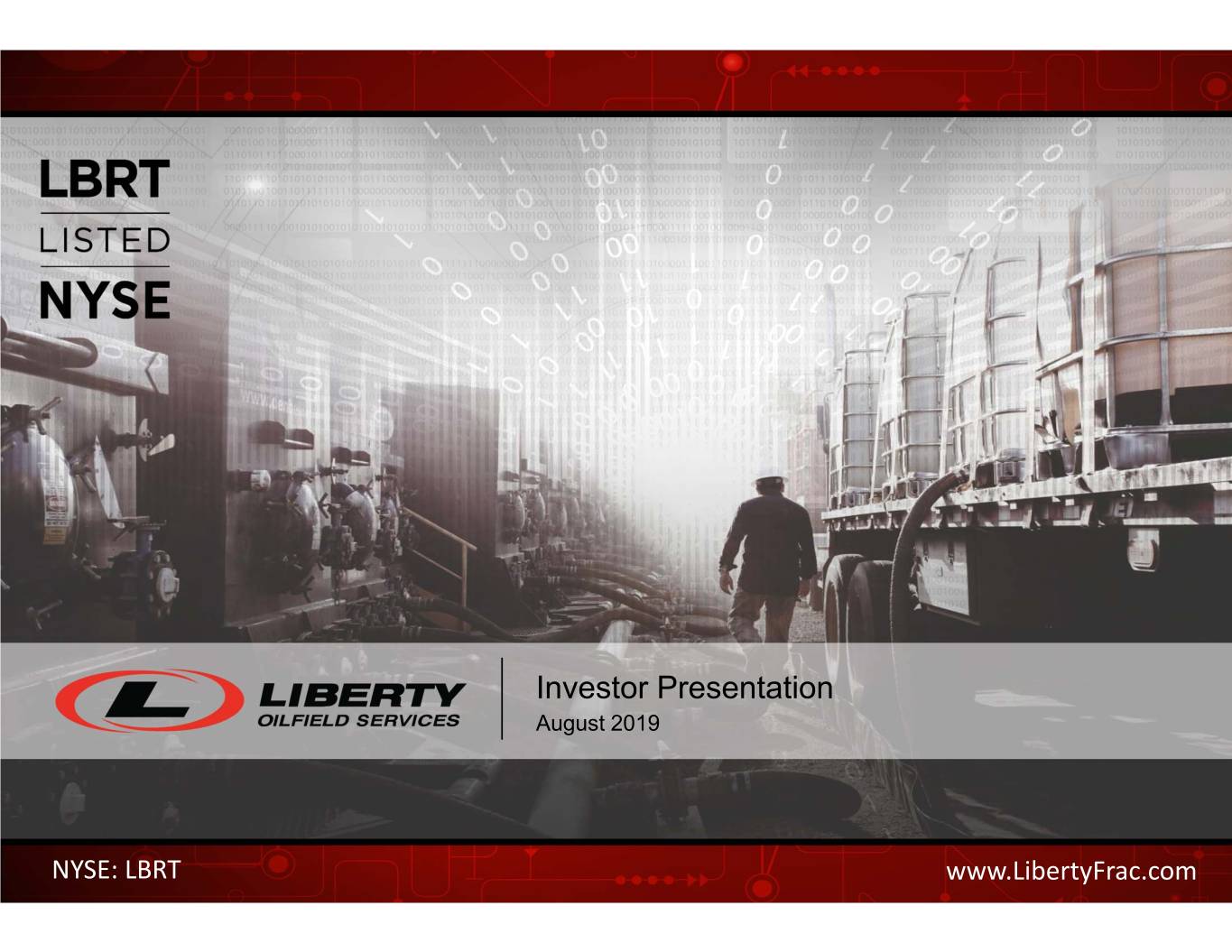
Investor Presentation August 2019 NYSE: LBRT www.LibertyFrac.com
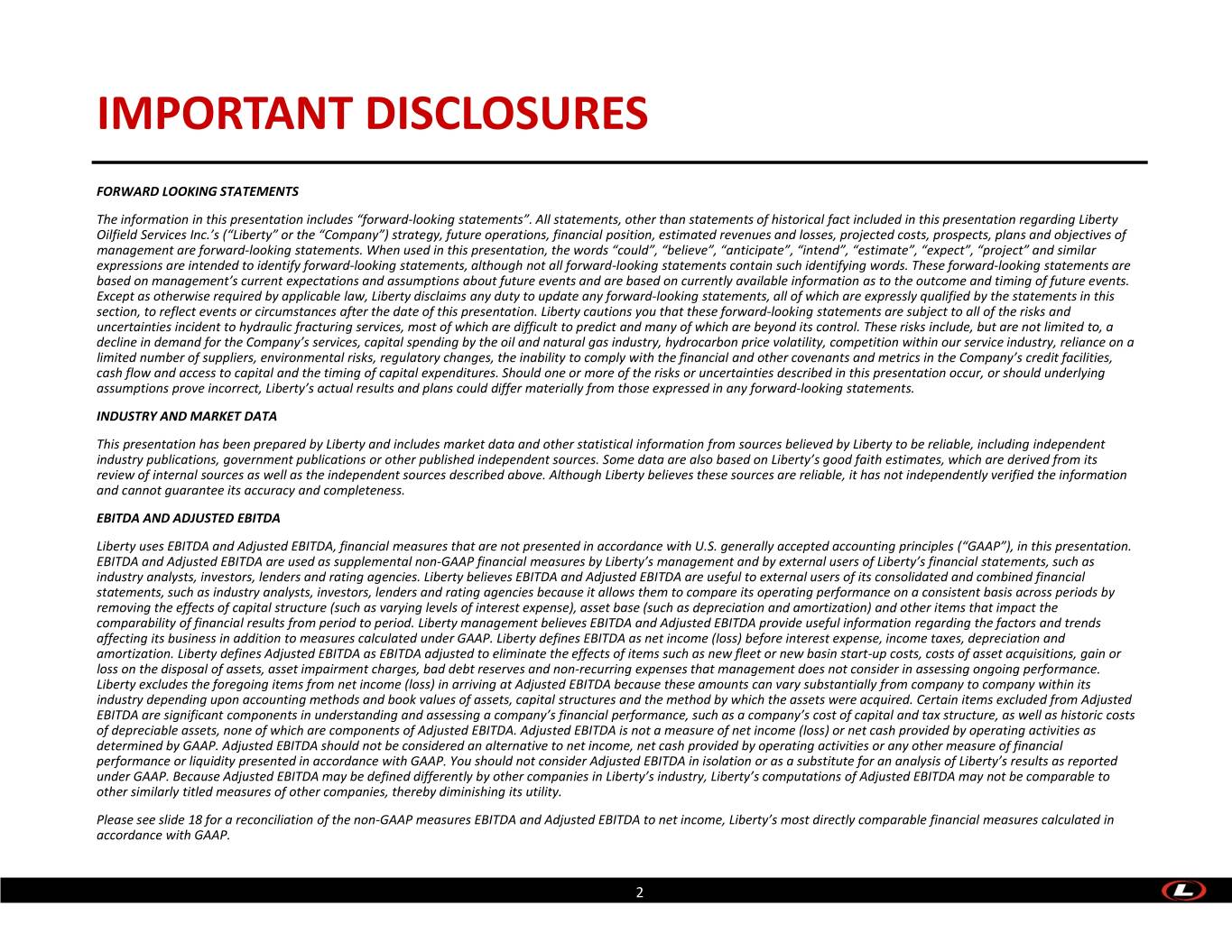
IMPORTANT DISCLOSURES FORWARD LOOKING STATEMENTS The information in this presentation includes “forward‐looking statements”. All statements, other than statements of historical fact included in this presentation regarding Liberty Oilfield Services Inc.’s (“Liberty” or the “Company”) strategy, future operations, financial position, estimated revenues and losses, projected costs, prospects, plans and objectives of management are forward‐looking statements. When used in this presentation, the words “could”, “believe”, “anticipate”, “intend”, “estimate”, “expect”, “project” and similar expressions are intended to identify forward‐looking statements, although not all forward‐looking statements contain such identifying words. These forward‐looking statements are based on management’s current expectations and assumptions about future events and are based on currently available information as to the outcome and timing of future events. Except as otherwise required by applicable law, Liberty disclaims any duty to update any forward‐looking statements, all of which are expressly qualified by the statements in this section, to reflect events or circumstances after the date of this presentation. Liberty cautions you that these forward‐looking statements are subject to all of the risks and uncertainties incident to hydraulic fracturing services, most of which are difficult to predict and many of which are beyond its control. These risks include, but are not limited to, a decline in demand for the Company’s services, capital spending by the oil and natural gas industry, hydrocarbon price volatility, competition within our service industry, reliance on a limited number of suppliers, environmental risks, regulatory changes, the inability to comply with the financial and other covenants and metrics in the Company’s credit facilities, cash flow and access to capital and the timing of capital expenditures. Should one or more of the risks or uncertainties described in this presentation occur, or should underlying assumptions prove incorrect, Liberty’s actual results and plans could differ materially from those expressed in any forward‐looking statements. INDUSTRY AND MARKET DATA This presentation has been prepared by Liberty and includes market data and other statistical information from sources believed by Liberty to be reliable, including independent industry publications, government publications or other published independent sources. Some data are also based on Liberty’s good faith estimates, which are derived from its review of internal sources as well as the independent sources described above. Although Liberty believes these sources are reliable, it has not independently verified the information and cannot guarantee its accuracy and completeness. EBITDA AND ADJUSTED EBITDA Liberty uses EBITDA and Adjusted EBITDA, financial measures that are not presented in accordance with U.S. generally accepted accounting principles (“GAAP”), in this presentation. EBITDA and Adjusted EBITDA are used as supplemental non‐GAAP financial measures by Liberty’s management and by external users of Liberty’s financial statements, such as industry analysts, investors, lenders and rating agencies. Liberty believes EBITDA and Adjusted EBITDA are useful to external users of its consolidated and combined financial statements, such as industry analysts, investors, lenders and rating agencies because it allows them to compare its operating performance on a consistent basis across periods by removing the effects of capital structure (such as varying levels of interest expense), asset base (such as depreciation and amortization) and other items that impact the comparability of financial results from period to period. Liberty management believes EBITDA and Adjusted EBITDA provide useful information regarding the factors and trends affecting its business in addition to measures calculated under GAAP. Liberty defines EBITDA as net income (loss) before interest expense, income taxes, depreciation and amortization. Liberty defines Adjusted EBITDA as EBITDA adjusted to eliminate the effects of items such as new fleet or new basin start‐up costs, costs of asset acquisitions, gain or loss on the disposal of assets, asset impairment charges, bad debt reserves and non‐recurring expenses that management does not consider in assessing ongoing performance. Liberty excludes the foregoing items from net income (loss) in arriving at Adjusted EBITDA because these amounts can vary substantially from company to company within its industry depending upon accounting methods and book values of assets, capital structures and the method by which the assets were acquired. Certain items excluded from Adjusted EBITDA are significant components in understanding and assessing a company’s financial performance, such as a company’s cost of capital and tax structure, as well as historic costs of depreciable assets, none of which are components of Adjusted EBITDA. Adjusted EBITDA is not a measure of net income (loss) or net cash provided by operating activities as determined by GAAP. Adjusted EBITDA should not be considered an alternative to net income, net cash provided by operating activities or any other measure of financial performance or liquidity presented in accordance with GAAP. You should not consider Adjusted EBITDA in isolation or as a substitute for an analysis of Liberty’s results as reported under GAAP. Because Adjusted EBITDA may be defined differently by other companies in Liberty’s industry, Liberty’s computations of Adjusted EBITDA may not be comparable to other similarly titled measures of other companies, thereby diminishing its utility. Please see slide 18 for a reconciliation of the non‐GAAP measures EBITDA and Adjusted EBITDA to net income, Liberty’s most directly comparable financial measures calculated in accordance with GAAP. 2 2
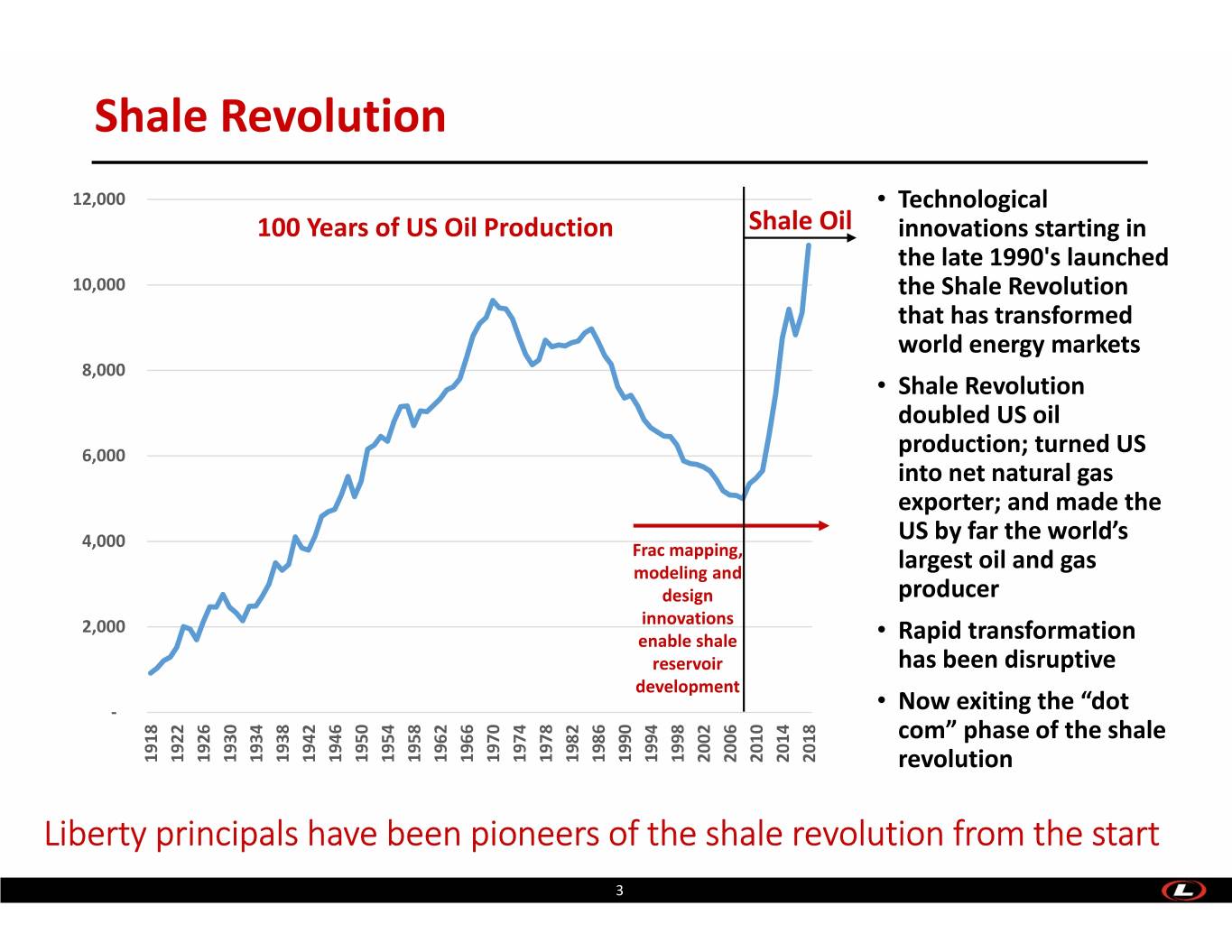
Shale Revolution 12,000 • Technological 100 Years of US Oil Production Shale Oil innovations starting in the late 1990's launched 10,000 the Shale Revolution that has transformed world energy markets 8,000 • Shale Revolution doubled US oil 6,000 production; turned US into net natural gas exporter; and made the US by far the world’s 4,000 Frac mapping, modeling and largest oil and gas design producer 2,000 innovations enable shale • Rapid transformation reservoir has been disruptive development ‐ • Now exiting the “dot com” phase of the shale 1918 1922 1926 1930 1934 1938 1942 1946 1950 1954 1958 1962 1966 1970 1974 1978 1982 1986 1990 1994 1998 2002 2006 2010 2014 2018 revolution Liberty principals have been pioneers of the shale revolution from the start 3
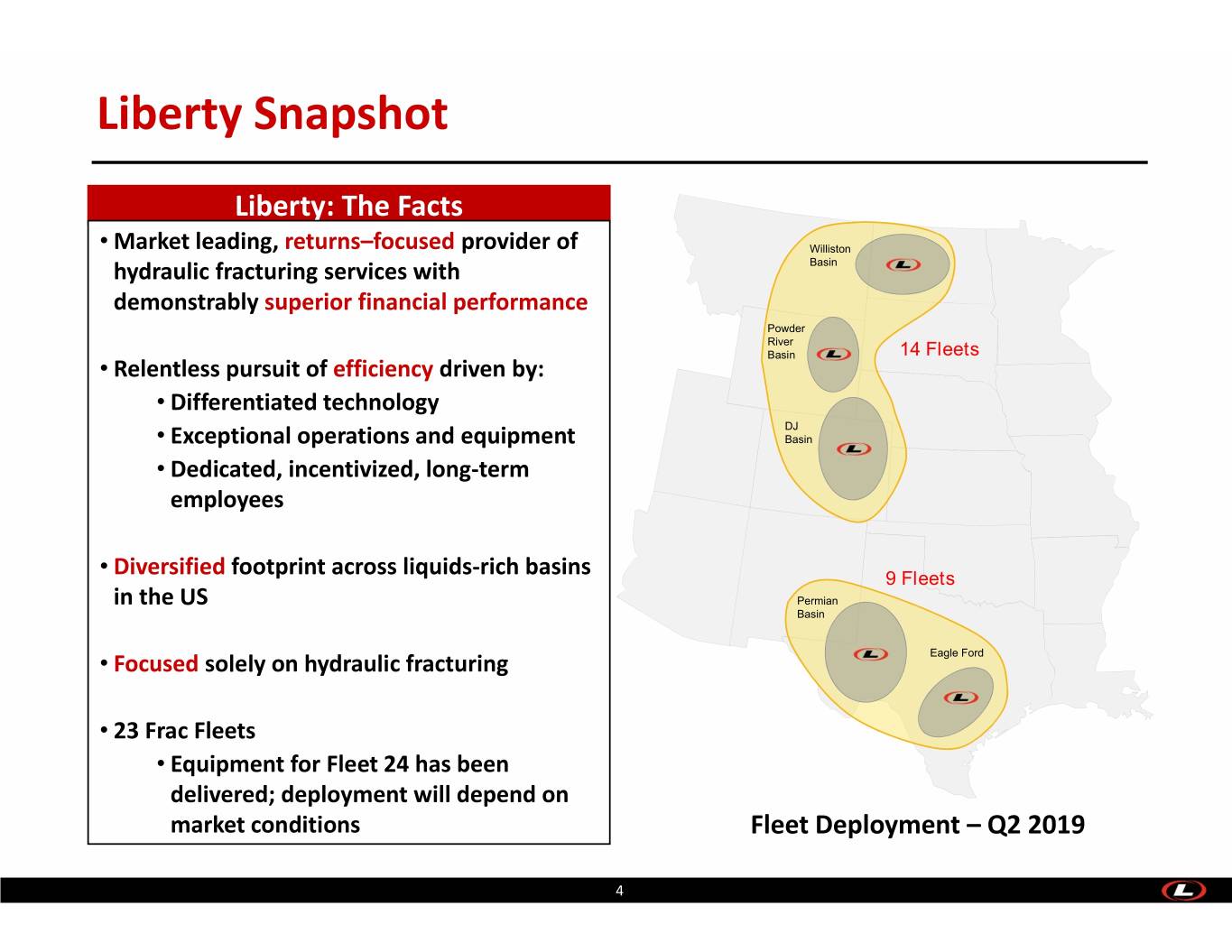
Liberty Snapshot Liberty: The Facts • Market leading, returns–focused provider of Williston hydraulic fracturing services with Basin demonstrably superior financial performance Powder River Basin 14 Fleets • Relentless pursuit of efficiency driven by: • Differentiated technology DJ • Exceptional operations and equipment Basin • Dedicated, incentivized, long‐term employees • Diversified footprint across liquids‐rich basins 9 Fleets in the US Permian Basin • Focused solely on hydraulic fracturing Eagle Ford • 23 Frac Fleets • Equipment for Fleet 24 has been delivered; deployment will depend on market conditions Fleet Deployment – Q2 2019 4

Where we play – Hydraulic Fracturing • Frac enables production from unconventional reservoirs • Largest single component of well capital spend • Total estimated 2018 lower 48 drilling and completion capex spend1: $90 Billion Breakdown of Avg. D&C Well Spend2 Other 22% Frac 42% Drilling 36% (1) Source: Coras Research (2) Source: Jefferies Research 5

Second Quarter 2019 Financial Highlights Driving Profitable Growth QTR vs • Revenues increased 1% $ MM's except Per Share and Fleet numbers Q2 2019 Q1 2019 QTR Revenue$ 542 $ 535 1% • Pre‐tax net income up 19% to Net Income Before Tax$ 48 $ 40 19% Fully Diluted EPS$ 0.32 $ 0.26 24% $48M Adjusted EBITDA$ 92 $ 85 9% Avg. Active Fleets 23.0 22.3 3% • Adjusted EBITDA up 9% to $92M Adj. EBITDA Per Fleet$ 16 $ 15 4% • Fully diluted EPS $0.32 Balance Sheet Strength June 30, March 31, QTR vs • Net Debt at quarter end $74M $ MM's 2019 2019 QTR Cash On Hand$ 33 $ 59 ‐45% Working Capital (Excl. Cash)$ 211 $ 174 21% • Quarter‐end liquidity > $250M Total Debt$ 107 $ 106 0% Net Debt$ 74 $ 48 56% • Including undrawn ABL availability Total Liquidity$ 266 $ 292 ‐9% • Return on Capital Employed 23% Capital Expenditures$ 44 $ 51 ‐14% • LTM Q2 2019 6
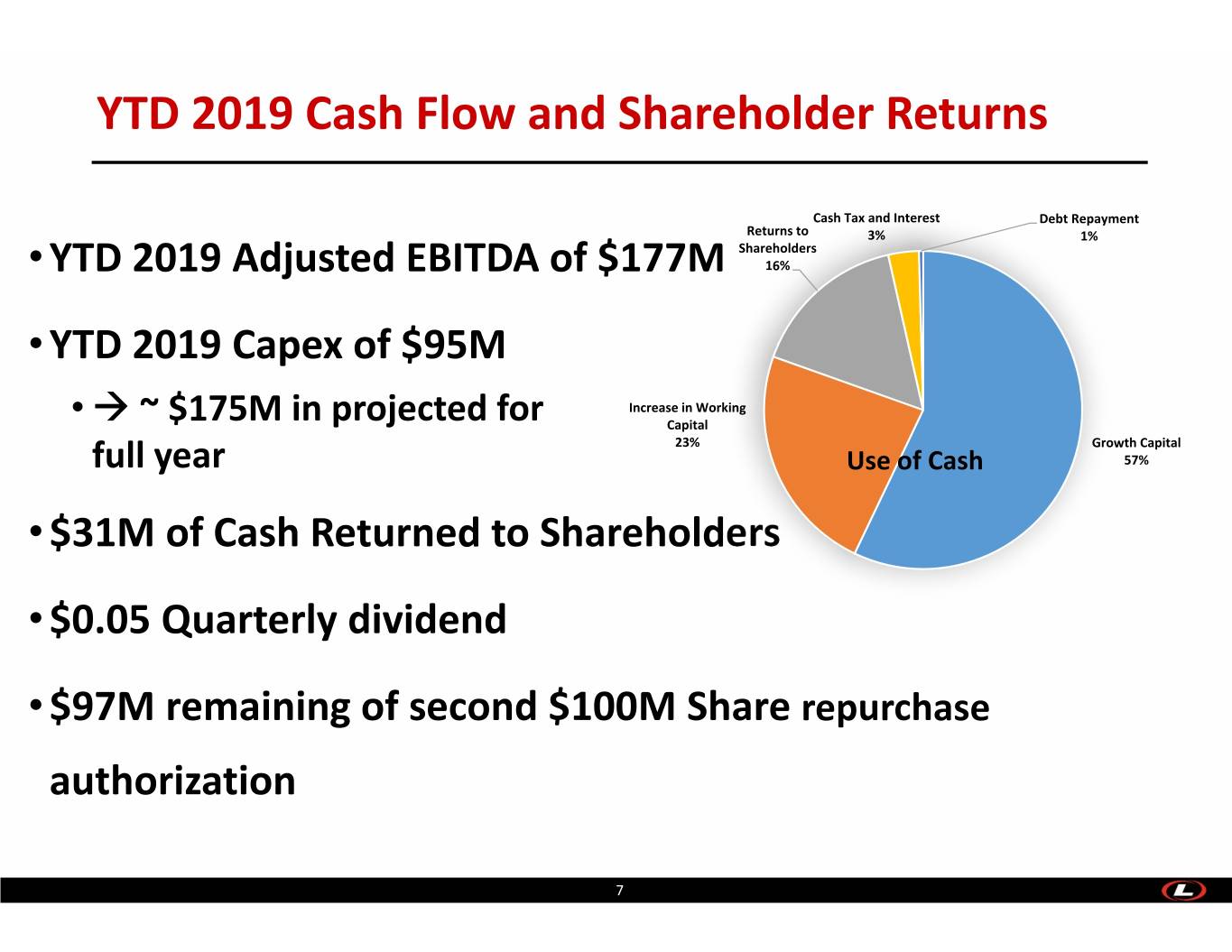
YTD 2019 Cash Flow and Shareholder Returns Cash Tax and Interest Debt Repayment Returns to 3% 1% Shareholders • YTD 2019 Adjusted EBITDA of $177M 16% • YTD 2019 Capex of $95M Increase in Working • ~ $175M in projected for Capital 23% Growth Capital full year Use of Cash 57% • $31M of Cash Returned to Shareholders • $0.05 Quarterly dividend • $97M remaining of second $100M Share repurchase authorization 7

Returns‐Focused Company Pre‐Tax Return on Capital Employed (ROCE)(1) ‐ LTM 2Q2019 Superior Returns 32% on Capital 23% Meticulous Focus on Frac and Frac 9% 7% Only 5% 2% Highly Profitable Operating (5%) Structure (9%) Disciplined Capital (26%) LBRT Pumper Pumper Pumper Pumper Pumper Pumper Large Cap 1 Large Cap 2 Investment 1 2 3 4 5 6 Industry Comparables(2) Liberty has the Highest Pre‐Tax Returns on Capital Employed compared to Peer Group Source: Public Filings (1) Pre‐Tax Return on Capital Employed (ROCE) is defined as the ratio of LTM 2Q2019 Pre‐Tax Net Income to the annual average Total Debt and Shareholders’ Equity as of June 30, 2019 and 2018. See Slide 19 for a detailed calculation for LBRT. (2) Pumpers include: CFW, CJ, FRAC, PTEN, PUMP, RES; Large Caps include HAL, SLB. Excludes companies with negative Shareholders’ Equity 8
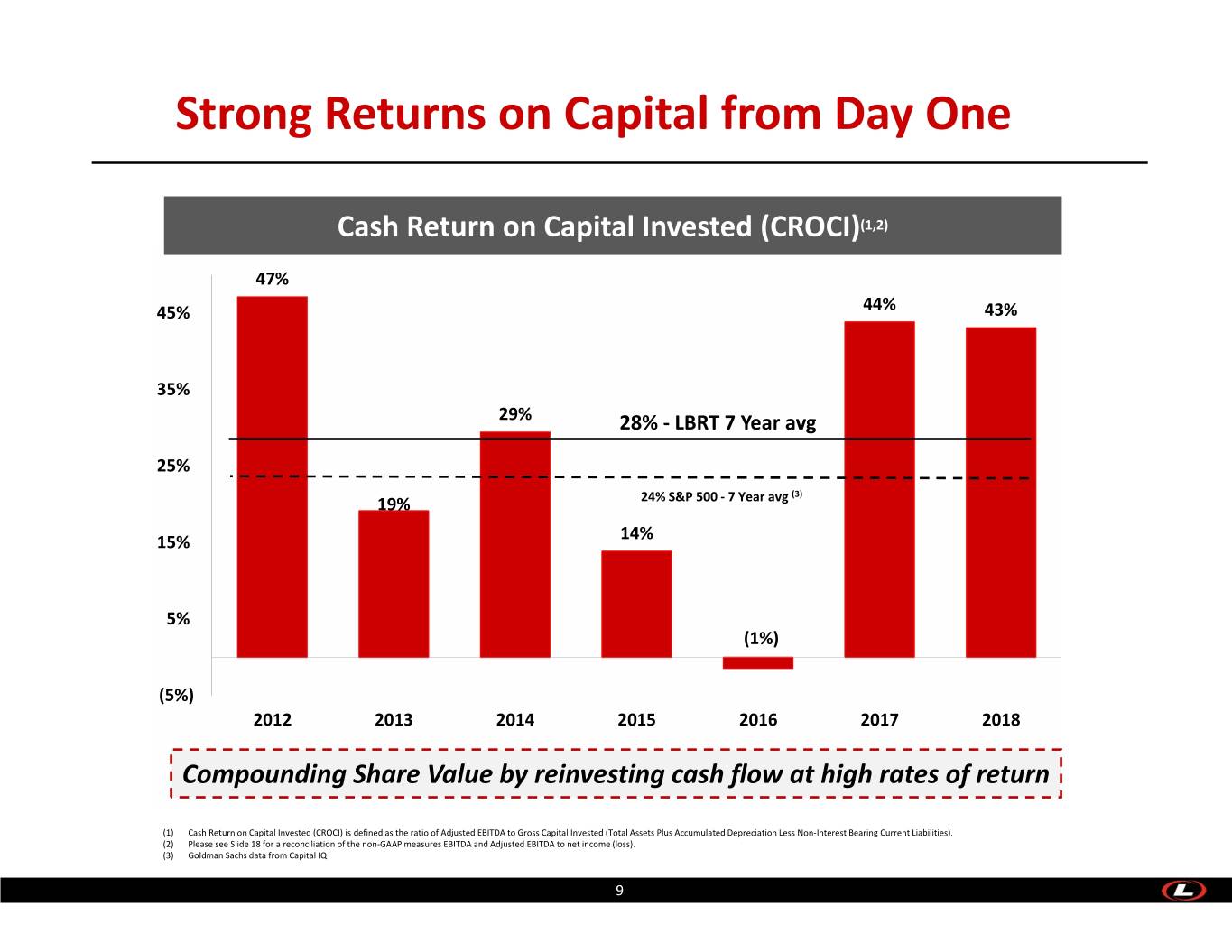
Strong Returns on Capital from Day One Cash Return on Capital Invested (CROCI)(1,2) 47% 45% 44% 43% 35% 29% 28% ‐ LBRT 7 Year avg 25% (3) 19% 24% S&P 500 ‐ 7 Year avg 15% 14% 5% (1%) (5%) 2012 2013 2014 2015 2016 2017 2018 Compounding Share Value by reinvesting cash flow at high rates of return (1) Cash Return on Capital Invested (CROCI) is defined as the ratio of Adjusted EBITDA to Gross Capital Invested (Total Assets Plus Accumulated Depreciation Less Non‐Interest Bearing Current Liabilities). (2) Please see Slide 18 for a reconciliation of the non‐GAAP measures EBITDA and Adjusted EBITDA to net income (loss). (3) Goldman Sachs data from Capital IQ 9

How We Generate Our Differential Returns People and Culture 2 Treat people right, empower employees, foster an innovation based culture, significantly lower turnover, common sense safety culture Technology Develop disruptive solutions that reduce our customers’ cost per BOE, maximize fleet efficiency, enhance logistics capabilities Customers Long‐term sticky partnerships with like‐minded, efficiency driven customers Relentless Focus on Efficiency Meticulously track 1,440 minutes per day, identify areas for improvement, transparent collaboration with customers 10

Liberty – The Employer of Choice Employee‐centered culture which attracts and retains high potential talent • Get the best talent and you win • Lower personnel turnover • Zero layoffs during the downturn • Safety first ‐ incident rate less than half of industry average • Highly variable compensation linked to safety, throughput, profitability and return on capital • Experienced, Incentivized Crews = Higher Throughput = Partner of Choice Source: Company disclosure, OSHA 11

Liberty DNA: Technology Meets Execution Technology Highlights Impact Liberty FracTrends™ • 60,000+ well database Proprietary Database • Proprietary viewer and analysis tools Fraconomics™ • Integrated engineering & “big data” approach to lower a customer’s cost to produce a barrel of oil • Liberty technology to enable customers to develop Liberty Quiet Fleet ® acreage in close proximity to populated areas Technology Enhanced • Real‐time control over last mile sand logistics for Proppant Logistics optimized trucking fleet utilization “Smart” Preventive • CAT‐partnered real‐time performance tracking and Maintenance predictive maintenance management 12
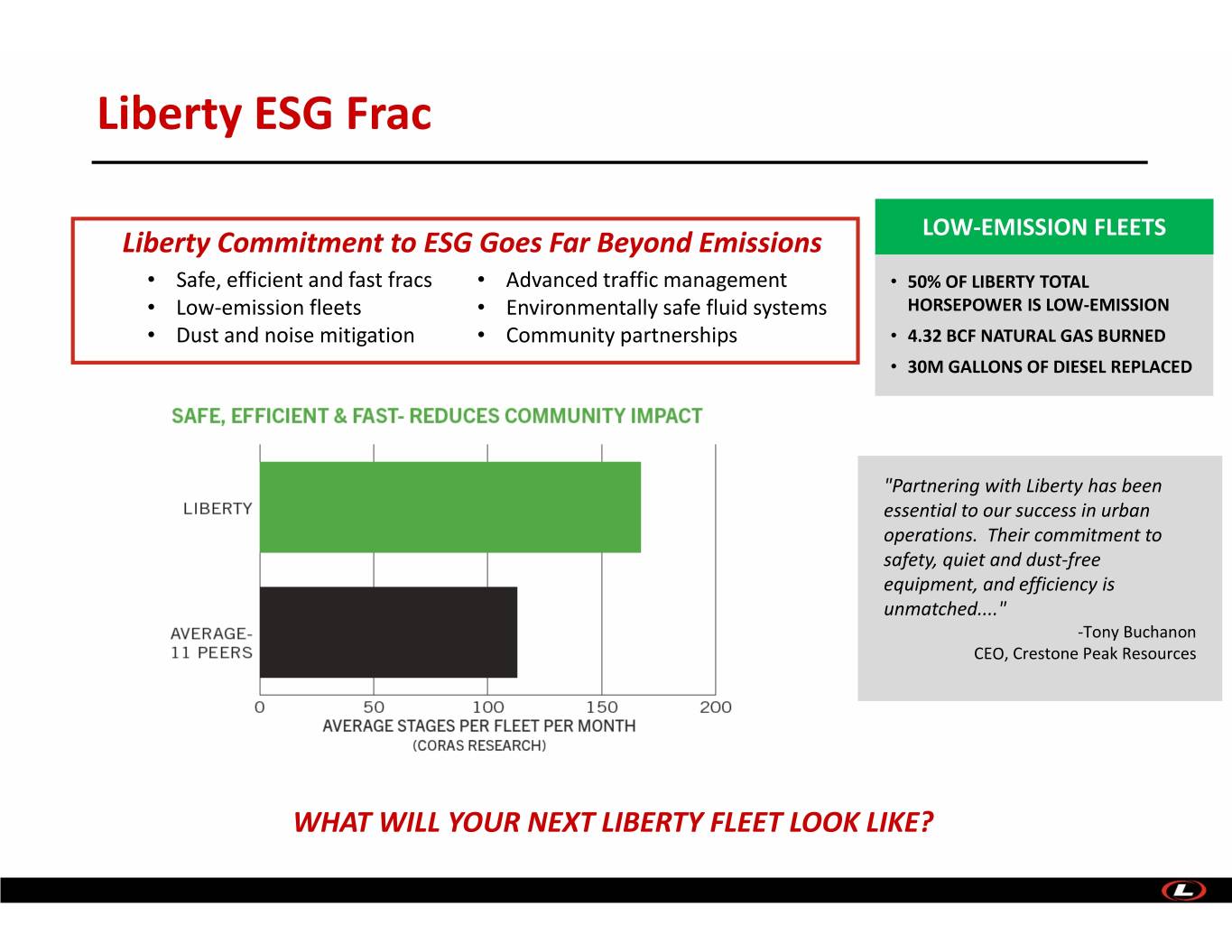
Liberty ESG Frac LOW‐EMISSION FLEETS Liberty Commitment to ESG Goes Far Beyond Emissions • Safe, efficient and fast fracs • Advanced traffic management • 50% OF LIBERTY TOTAL • Low‐emission fleets • Environmentally safe fluid systems HORSEPOWER IS LOW‐EMISSION • Dust and noise mitigation • Community partnerships • 4.32 BCF NATURAL GAS BURNED • 30M GALLONS OF DIESEL REPLACED "Partnering with Liberty has been essential to our success in urban operations. Their commitment to safety, quiet and dust‐free equipment, and efficiency is unmatched...." ‐Tony Buchanon CEO, Crestone Peak Resources WHAT WILL YOUR NEXT LIBERTY FLEET LOOK LIKE?13
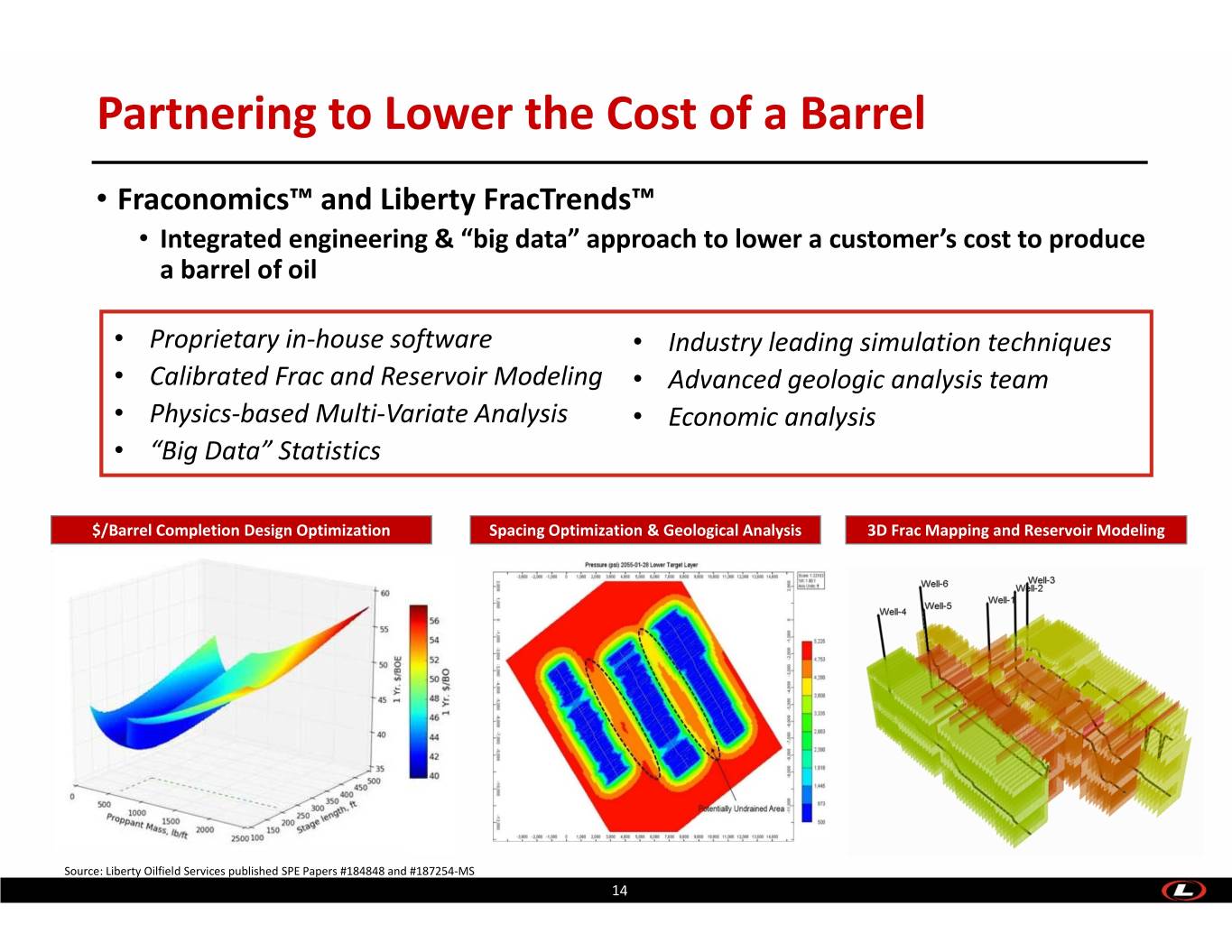
Partnering to Lower the Cost of a Barrel • Fraconomics™ and Liberty FracTrends™ • Integrated engineering & “big data” approach to lower a customer’s cost to produce a barrel of oil • Proprietary in‐house software • Industry leading simulation techniques • Calibrated Frac and Reservoir Modeling • Advanced geologic analysis team • Physics‐based Multi‐Variate Analysis • Economic analysis • “Big Data” Statistics $/Barrel Completion Design Optimization Spacing Optimization & Geological Analysis 3D Frac Mapping and Reservoir Modeling Source: Liberty Oilfield Services published SPE Papers #184848 and #187254‐MS 14

Relentless Focus on Operational Efficiency • We track all 1,440 minutes on every fleet, Higher Throughput By Lowering Non‐Performing Time (NPT) every day Example Pad Customer NPT • Meticulous downtime analysis to Activity Breakdown Breakdown determine root‐cause and engineer 8% technology driven solutions 22% 59% 32% • Collaborative and transparent partnership 70% 9% with customers to reduce Non‐Performing time Customer NPT Wellhead Operations • Maximize Throughput Liberty NPT 3rd Party Maintenance Waiting on Wireline • Decrease Maintenance Cost Pumping Predictive Maintenance Reduces Downtime Downtime Tracking Enables Solution Development 15
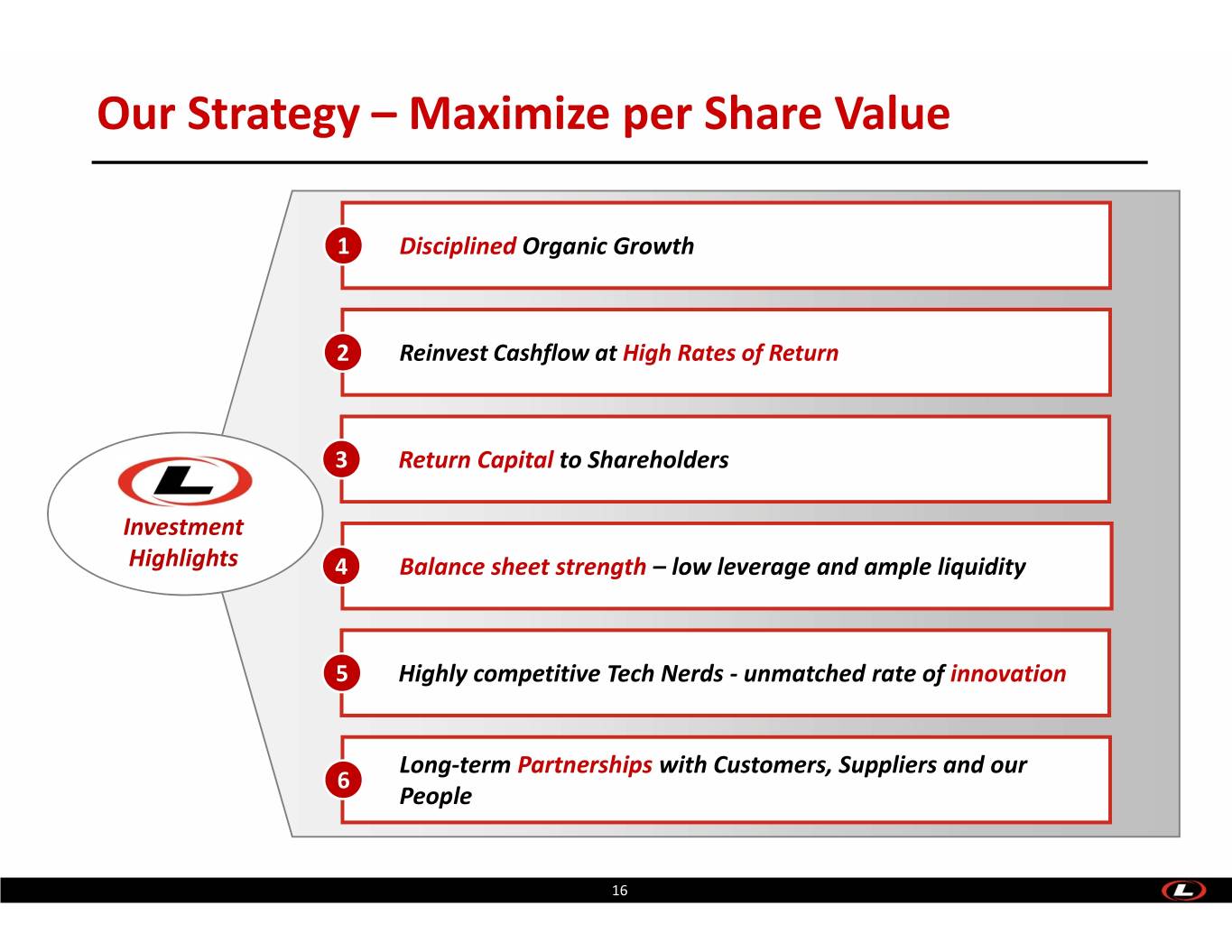
Our Strategy – Maximize per Share Value 1 Disciplined Organic Growth 2 Reinvest Cashflow at High Rates of Return 3 Return Capital to Shareholders Investment Highlights 4 Balance sheet strength – low leverage and ample liquidity 5 Highly competitive Tech Nerds ‐ unmatched rate of innovation Long‐term Partnerships with Customers, Suppliers and our 6 People 16
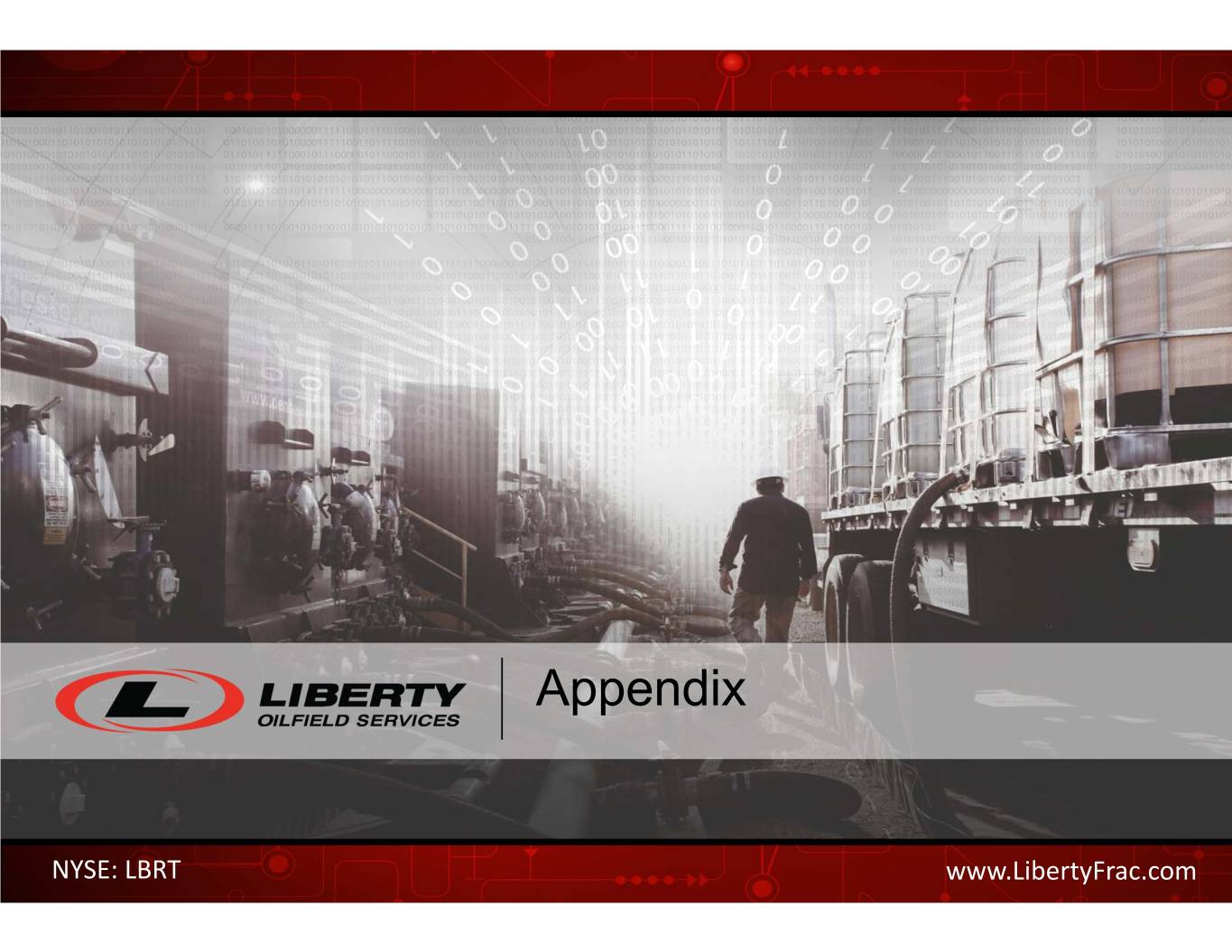
Appendix NYSE: LBRT www.LibertyFrac.com
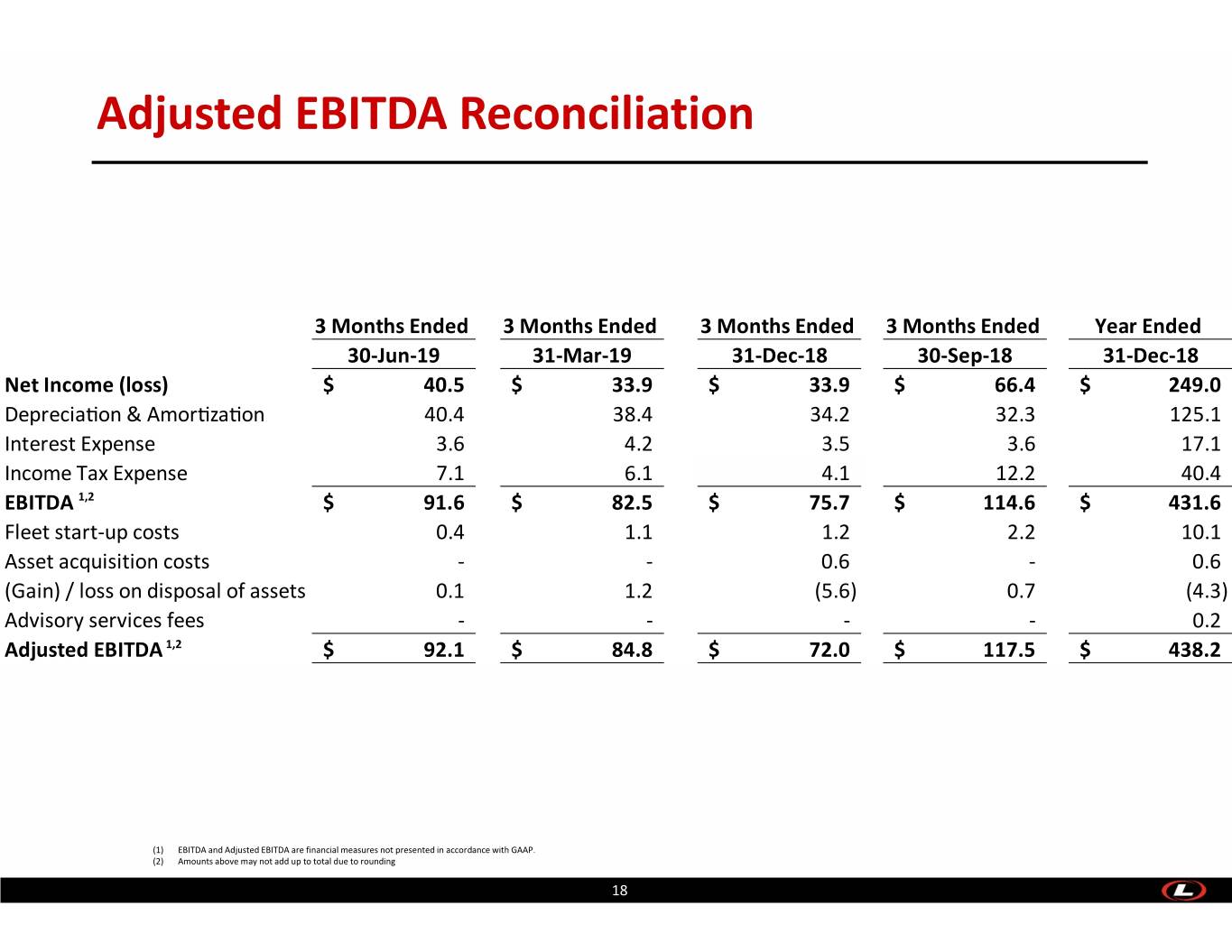
Adjusted EBITDA Reconciliation 3 Months Ended 3 Months Ended 3 Months Ended 3 Months Ended Year Ended 30‐Jun‐19 31‐Mar‐19 31‐Dec‐18 30‐Sep‐18 31‐Dec‐18 Net Income (loss)$ 40.5 $ 33.9 $ 33.9 $ 66.4 $ 249.0 Deprecia�on & Amor�za�on 40.4 38.4 34.2 32.3 125.1 Interest Expense 3.6 4.2 3.5 3.6 17.1 Income Tax Expense 7.1 6.1 4.1 12.2 40.4 EBITDA1,2 $ 91.6 $ 82.5 $ 75.7 $ 114.6 $ 431.6 Fleet start‐up costs 0.4 1.1 1.2 2.2 10.1 Asset acquisition costs ‐ ‐ 0.6 ‐ 0.6 (Gain) / loss on disposal of assets 0.1 1.2 (5.6) 0.7 (4.3) Advisory services fees ‐ ‐ ‐ ‐ 0.2 Adjusted EBITDA1,2 $ 92.1 $ 84.8 $ 72.0 $ 117.5 $ 438.2 (1) EBITDA and Adjusted EBITDA are financial measures not presented in accordance with GAAP. (2) Amounts above may not add up to total due to rounding 18
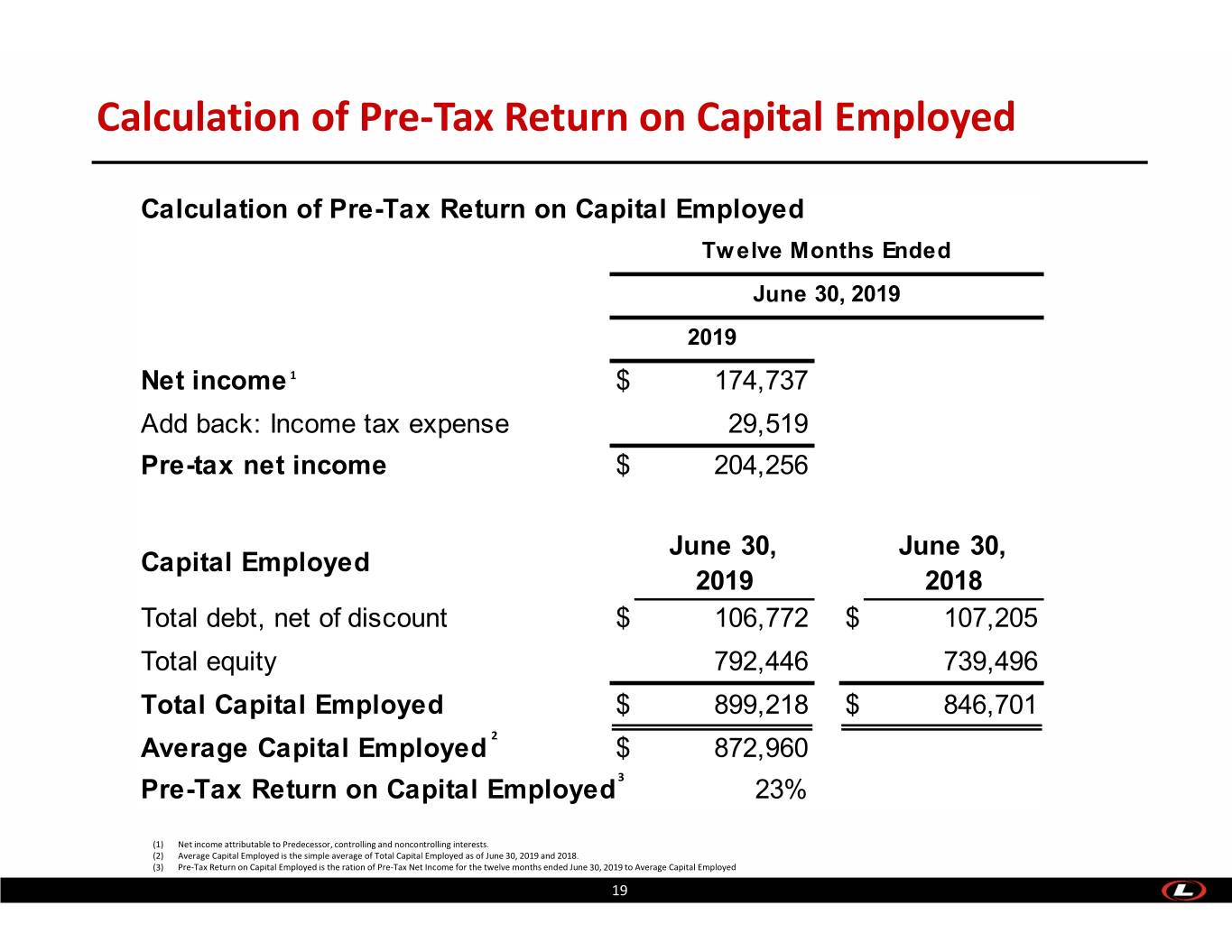
Calculation of Pre‐Tax Return on Capital Employed Calculation of Pre-Tax Return on Capital Employed Twelve Months Ended June 30, 2019 2019 Net income 1 $ 174,737 Add back: Income tax expense 29,519 Pre-tax net income $ 204,256 June 30, June 30, Capital Employed 2019 2018 Total debt, net of discount $ 106,772 $ 107,205 Total equity 792,446 739,496 Total Capital Employed $ 899,218 $ 846,701 Average Capital Employed2 $ 872,960 Pre-Tax Return on Capital Employed3 23% (1) Net income attributable to Predecessor, controlling and noncontrolling interests. (2) Average Capital Employed is the simple average of Total Capital Employed as of June 30, 2019 and 2018. (3) Pre‐Tax Return on Capital Employed is the ration of Pre‐Tax Net Income for the twelve months ended June 30, 2019 to Average Capital Employed 19


















